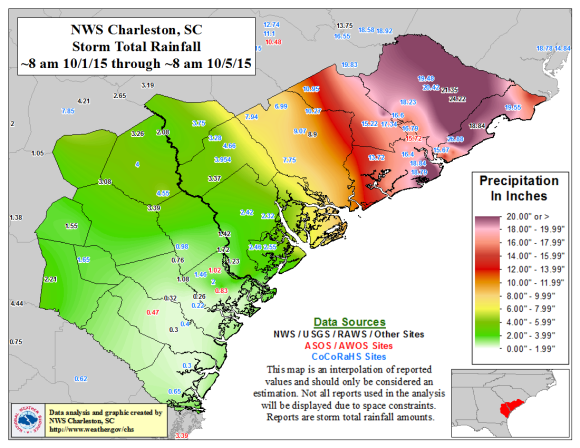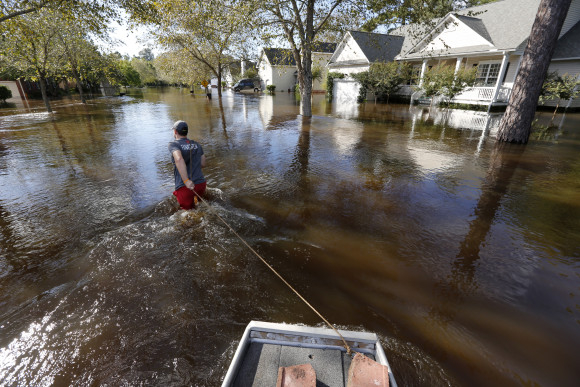The claims filing and damage recovery process is underway in South Carolina after the mega-storm that hit the state Oct. 1 through Oct. 5 brought extensive damage statewide with some areas receiving more than two feet of rain.
A total damage estimate is still not yet available.
South Carolina Insurance Director Raymond Farmer said no event on record compares to what South Carolina endured, but the insurance industry and South Carolina residents will recover.
“No one alive today has ever seen anything like this. Experts are saying this is a 1 in 1,000 year flood – I don’t want to see another. It’s devastating,” he said.
Farmer said some portions of the state had received in excess of two feet of rain after the early October weekend storm. Authorities reported 19 deaths had been linked to the storm as of Oct. 11, as well as immeasurable property damage from toppled trees and flooding. Catastrophe modeling firm AIR Worldwide said one-day rainfall records were set all over the state.
The storm resulted from remnants of Hurricane Joaquin, which bypassed land but brought tropical moisture from offshore. The mega-storm conditions hit many areas of the Southeast coast beginning Oct. 1, with South Carolina bearing the brunt of it over the next several days.
South Carolina Gov. Nikki Haley said on Oct. 12 flooding caused 27 dams to burst and nearly 247 more were still being monitored to make sure they’d hold. Additional rain fell Oct. 10 bringing October’s total precipitation in the state’s capital of Columbia to 12.75 inches – breaking the previous record of 12 inches in 1959 for all of October, according to the National Weather Service.
AIR Worldwide said the one-day rainfall records for October were broken in at least nine cities, with six of them breaking the one-day record for any month. The total rainfall from October 2-6 exceeded 20 inches in several areas, including parts of Brunswick, Georgetown, and Horry counties. Numerous rivers statewide surpassed their flood stages.
Recovery Efforts
Gov. Haley declared a state of emergency for the state on Oct. 1 and President Obama signed an emergency declaration that allows the Federal Emergency Management Agency (FEMA) to provide federal emergency aid to the state to supplement state, local, and tribal response efforts in the areas affected by the storms and flooding beginning Oct. 1.
The South Carolina Department of Insurance issued a bulletin Oct. 5 to all insurers, adjusters, producers and other persons licensed and authorized to transact insurance in South Carolina allowing non-resident, temporary adjusters to be available to assist with the evaluation of claims in the state. Farmer said it was a necessary action after the early October weekend weather left insurers short-staffed to respond. Gov. Haley reported Oct. 12 that 503 additonal adjusters had been approved in addition to the 2,800 adjusters already in the state. SCDOI issued a Notice of Emergency Licensure of Motor Vehicle Physical Damage Appraisers on Oct. 12 to ensure appraisers are available to assist with the evaluation of auto claims for South Carolina consumers.
“We are doing everything possible to accommodate adjusters and the insurance industry as they start to deal with this event,” he said. “We expected a lot of damage, but I don’t know if anybody could have expected what we ended up with. This will be a multi-year event to come back from.”
Farmer issued an emergency order and regulation on Oct. 9 prohibiting insurers from canceling policies between Oct. 8 and Nov. 1, 2015 for insureds listed in the federal disaster declaration. The emergency regulation also prohibits insurers from canceling or nonrenewing policies solely because of claims resulting from the catastrophic event.
Ann Roberson, executive assistant to the Director and the public information officer for the SCDOI, said no insurers had cancelled policies when the regulation was issued, but SCDOI was taking proactive action in this incidence. The regulation also extends the deadlines for payment of insurance premiums and other required correspondence for 30 days, but does not exempt or excuse insureds from making premium payments. The emergency regulation does not apply to workers’ compensation policies or to new policies issued after Oct. 12.
“This action is intended to assist those who have been displaced or whose homes have been damaged or destroyed, making it difficult for them to find documents, checkbooks and credit cards or whose mail service may have been disrupted,” said Farmer.
Farmer’s agency also organized a Catastrophe Claims Center in Columbia Oct. 7 and Oct. 8 and in North Charleston Oct. 14. Claims representatives from several insurers, as well FEMA, were on hand to help citizens get started on the recovery process and answer any questions.
“The mood is ‘This has happened – how do I move on from here? What does my insurance cover and what does it not cover?'” Farmer said.
Companies and service organizations on site included: Allstate, Independent Insurance Agents and Brokers of South Carolina; Nationwide; USAA; State Auto Insurance Companies; South Carolina Farm Bureau Mutual Insurance Co.; South Carolina Insurance News Service; State Farm; and St. Johns Insurance Co.
“We need to be here for our citizens and we need to be out in the community when something like this happens,” said Farmer.
Cost of Damage
Estimates of the total damage were still not available from SCDOI when Insurance Journal went to print Oct. 13, as flooding was expected to continue in some areas through Oct. 14, according to the National Weather Service, creating the possibility for more damage and many more claims. Roberson said SCDOI expects to have an estimate after mid-month.
Allstate spokesperson Daniel Groce said it’s too soon for the second largest home and auto insurer in the state to know the total number of claims it expects.
“We’re encouraging all residents impacted by the storm to begin the claims process with their insurance carrier,” Groce said.
On the auto side, Farmer said tens of thousands of auto claims are expected that are covered by comprehensive coverage. State Farm, the largest personal auto and homeowners insurer in the state, said Oct. 12 approximately 2,500 auto claims and 3,770 homeowners claims had already been filed.

Flood insurance claims will not be as high as flood is excluded on standard homeowners, renters and business insurance policies. The Insurance Information Institute (I.I.I.) reported that as of July 31, South Carolina had 199,540 National Flood Insurance Program policies in force with written premiums totaling $133.4 million covering $50.8 billion in property and contents.
“It appears we are going to have a lot of uninsured damage in the Columbia area. While some consumers had flood insurance, many that had damage were not in high risk flood areas,” said Frank Sheppard, president of the Independent Insurance Agents and Brokers of South Carolina (IIABSC).
FEMA said it expects many flood insurance claims will be uninsured but the following South Carolina counties were approved for federal disaster aid as of Oct. 9 and more could be added: Bamberg, Berkeley, Charleston, Clarendon, Colleton, Dorchester, Georgetown, Greenwood Horry, Lexington, Orangeburg, Richland, Sumter, and Williamsburg. It reported 36,000 residents had applied for assistance and $13 million in aid had been approved as of Oct. 12.
FEMA’s financial assistance recovery program can include grants for temporary housing, home repairs, low-cost loans to cover uninsured property losses, and other individuals and businessowner programs.
“Agents are reporting a lot of inquiries about damage though the insured understands they didn’t have flood insurance,” said Sheppard.
Farmer expects there will be significant commercial claims as well.
“There is a lot of commercial exposure here. A lot of businesses are still not open yet because our water system has been compromised and many of those who have water are still under a boil water alert,” he said Oct. 7.
Liberty Mutual and AIG were the largest commercial insurers in the state in 2014, according to the Insurance Information Institute (I.I.I.), with 5.7 percent of the market share and over $183 million in direct premiums written. Liberty Mutual declined to comment and AIG didn’t respond to an interview request.
The Associated Press reported preliminary estimates of crop losses could total more than $300 million in the state’s $3 billion-a-year agriculture industry. For farmers, the worst of the flood damage was in low lying fields that spent days in standing water, hitting peanuts, cotton and soybeans especially hard, Agriculture Commissioner Hugh Weathers said via the AP. He plans to request federal aid.
“Underneath that water is the South Carolina we remember. Underneath that water is that state that is so beautiful – that is damaged, but we have to fix it,” said Gov. Haley.
Topics Carriers Auto Agencies Legislation Claims Windstorm Flood Agribusiness Market South Carolina
Was this article valuable?
Here are more articles you may enjoy.



 Florida Governor Signs Wind-Mitigation Funding Bills for Homes, Condos
Florida Governor Signs Wind-Mitigation Funding Bills for Homes, Condos  Two Montgomery Workers Charged with Insurance Fraud in Alabama
Two Montgomery Workers Charged with Insurance Fraud in Alabama  Growing Progressive Set to Hire 10,000+ in Claims, IT, Other Roles
Growing Progressive Set to Hire 10,000+ in Claims, IT, Other Roles  Growing Wildfire Risk Leaves States Grappling With How to Keep Insurers From Fleeing
Growing Wildfire Risk Leaves States Grappling With How to Keep Insurers From Fleeing 


